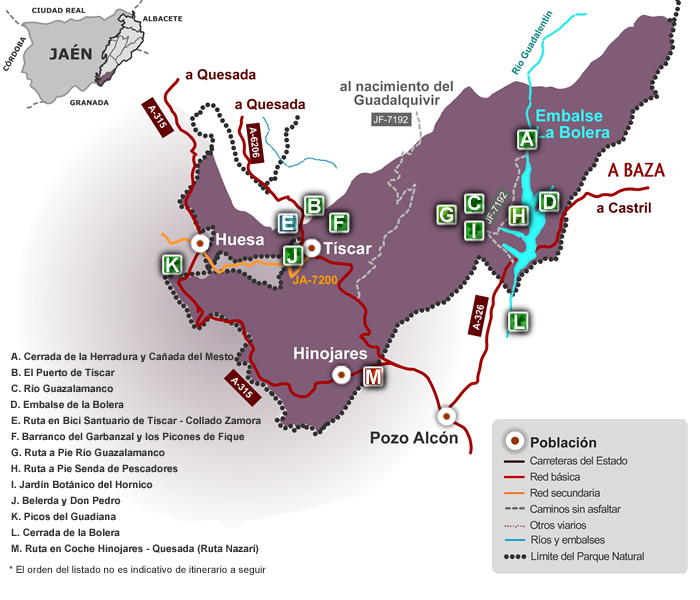Two Opposite Worlds
The southern end of the Natural Park is a box of surprises. In just one hour you will travel through 10,000 years of geological history and go from almost Alpine environments to sub-desert landscapes. Between the two worlds, the miracle of water: the wonderful Agua de Tíscar Cave, very close to the port and the sanctuary of the same name. One of these two worlds - the one above - holds such a wealth of fauna and flora that most of it is integrated in a Reserve Area and houses a group of laricio pines catalogued as the oldest trees in the Iberian Peninsula. The other world - the one below - will evoke the magic of one of the few European sub-desert environments.
The south of the Park is made up of four mountain ranges. The sierras of Cazorla, el Pozo, Quesada and La Cabrilla are well-defined orographic units, separated by large ravines and small valleys, which give the landscape a surprisingly alpine appearance. But the Natural Park does not end there. To the west, the Guadiana Menor river runs through a wide valley, which is a desert-like, arid depression, as if it were a piece of a puzzle found in the wrong box. It is difficult to imagine such a sharp contrast in the landscape over such a short distance.
This diversity of landscapes and environments in such a small space is the main sign of identity of this area of the Park. Long after the formation of the mountains of the Pozo and Quesada ranges, only 20,000 years ago, there was a gigantic inland lake in the whole region that accumulated mud and sediments from those mountains, but about 11,000 years ago, an enormous movement of the earth's crust tipped the region, the rivers changed their course and the lake disappeared, leaving its sandy bottom behind. The Guadiana Menor Steppes Depression is the consequence of these geological events
From then until today - a sigh in terms of geological history - the rivers of the ancient basin joined together to form the aforementioned river, which is one of the main tributaries of the Guadalquivir.
In such a short time, the waters have eroded the impermeable clays, loaded with gypsum and salt, from the bottom of the old lake, producing wear and tear of up to 400 metres in height. Furthermore, the "rain shadow" effect caused by the surrounding mountains makes this valley one of the areas where it rains least in Europe, with an average rainfall of no more than 300 mm.
The Sierra del Pozo emerges from the almost bare clays and is one of the best conserved areas in the whole Natural Park, which is why almost its entire surface is part of the Navahondona-Guadahornillos Reserve Area. This mountain range is home to all kinds of forest and plant formations, with alpine environments at the summits and a humid mountain climate. At the foot of Cabañas Peak, there is the Puerto Llano pine forest, where rainfall exceeds 1,600 mm, there is a monumental botanical complex where the thirty oldest trees in the Iberian Peninsula are found, according to studies carried out by the Consejo Superior de Investigaciones Científicas. The most incredible thing is that, between these two very different worlds, the desert and the high mountain forest, there are barely 10 km in a straight line. Anyone else?




